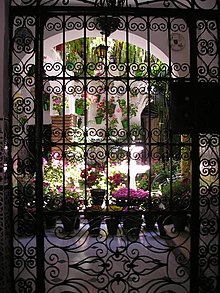Patio

A patio (/ˈpæti.oʊ/,[1] from Spanish: patio [ˈpatjo]; "courtyard", "forecourt", "yard") is an outdoor space generally used for dining or recreation that adjoins a residence and is typically paved.
The word comes to English from Spanish, where it has a different meaning, namely a roofless inner courtyard.
Patios are most commonly constructed from paving slabs (also known as paving flags). There are two main types of paving slab; concrete or stone. Concrete slabs are cheaper than their natural stone counterparts. This is because the cost of production is far lower. Concrete slabs are produced solely within a manufacturing plant unlike natural stone which is extracted from quarries.[2]
As well as paving slabs, patios can also be created using other durable surfaces such as bricks, block paving, tile, concrete, natural paving stones or cobbles.
See also
Notes
- ^ "Patio in the Oxford Dictionary".
{{cite web}}: Cite has empty unknown parameter:|1=(help) - ^ "Types of Patio Paving". SE Landscape Construction Ltd.
References
- Chisholm, Hugh, ed. (1911). . Encyclopædia Britannica (11th ed.). Cambridge University Press.
